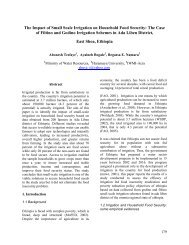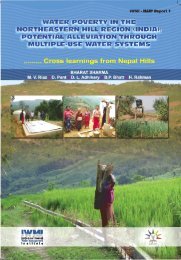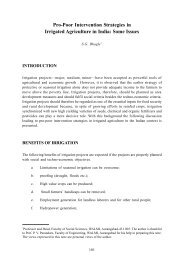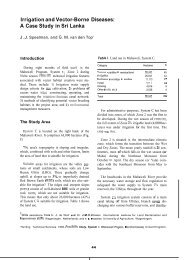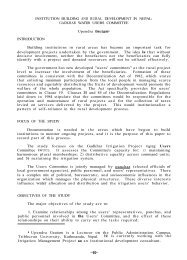A Case Study from System H, Sri Lanka
A Case Study from System H, Sri Lanka
A Case Study from System H, Sri Lanka
- No tags were found...
Create successful ePaper yourself
Turn your PDF publications into a flip-book with our unique Google optimized e-Paper software.
Executive SummaryTHEMAHA~~OANOA Developmenthgramme hamessesthe watersof theMahaweli, thelongestriverin<strong>Sri</strong><strong>Lanka</strong>. TheMahaweli Authority of <strong>Sri</strong> <strong>Lanka</strong>, the implementing agency, has undertaken an accelerated program of developmentworktoprovideirrigationwaterto99,176hectares(215,000acres)ofnew lands,74.888 hectares(185.000acres)oflandsthat were to get supplementary irrigation, and to generate 540 megawatts of hydropower.The new lands being developed are in various locations in the Dry Zone and have been divided into several systems andprojects. The allocation of diverted Mahaweli water to each project for each season is decided by a central WaterManagement Secretariat.<strong>System</strong> H is located in the dry zone in the North Central Province of <strong>Sri</strong> <strong>Lanka</strong> and is divided into three projects.Cultivatingthefullextentof<strong>System</strong>Hinbothseasonsoftheyearisadesirableobjective. butdueto watershortages whichoccurprincipallyinyulu(dryseason), thecultivableextent islimited. Thesavingofirrigation waterinmuhu(wetseason)is therefore important for increasing the cultivation in yulu.The water management efforts made to realize this objective, using two different approaches in the H5 subsystem of<strong>System</strong> H, and the significant results achieved, are discussed in this paper.INITIAL APPROACHThe fanner institution for water management is involved only at the field channel level. A group of 6-15 farmers, eachhaving a farm holding of 1 hectare fed by a field channel of 1 cum (28.3 literdsecond) capacity, has a leader. Watermanagement in the H5 area was initially practiced on apredetermined fixed schedule basis. The water deliveries intofield channels was rotated on a 5-10 day basis. Farmers received water almost on the same day of each rotational weekto irrigate the land. The field channel organization leader is required to distribute the water delivered to the field channelamong the allotments. The issue of water was curtailed when there was sufficient rainfall to stop one or more rotations.In the early stages of the project this approach contributed to discipline the farmers in water management. They beganto realize the importance of working in close coordination with water management officials for the planning and deliveryof water.However, this rigid predetermined irrigation schedule, especially at the land preparation stage, could not be synchronizedwith the actual needs of the fanns. The farmer was not always able to follow the officer’s instructions regardingland preparation. Lack of farmer/officer communication resulted in wastage of water. The officers were unaware of theday-to-day problems faced by the farmers and the farmers were not always ready to use the irrigation water that theofficers allocated. The method of utilization of rainfall WBS ineffective and resulted in a wastage of water.xv



